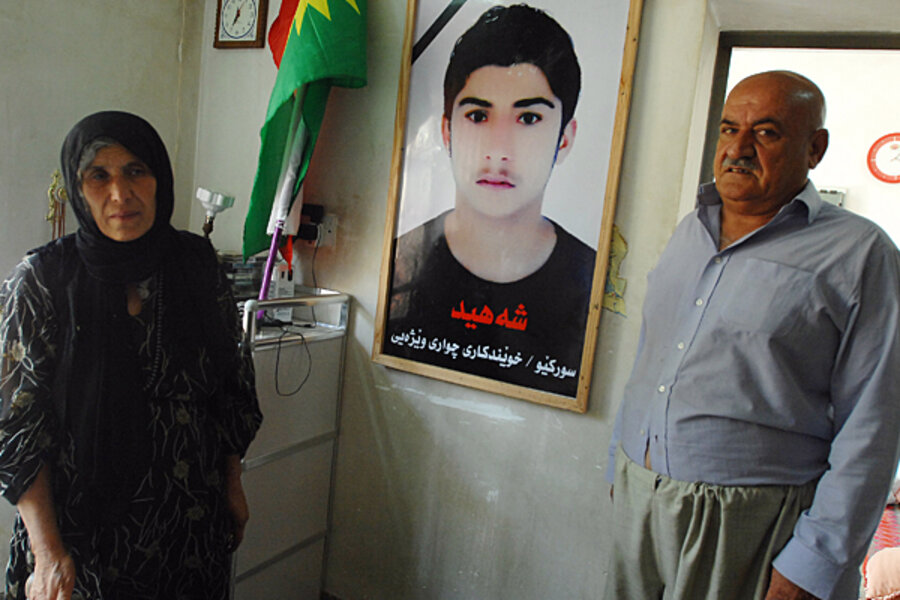A Kurdish family's loss symbolizes northern Iraq's unmet promise
Loading...
| Sulaymaniyah, Iraq
Proud as he was of his youngest son, Zahd Mahmoud Qaradaxi never wanted him to become a martyr for democracy in Iraqi Kurdistan.
And yet, the 16-year-old student photographer Swrkew (pronounced Sir-kee-yew) was one of the first to die in the 62-day pro-democracy protests that rocked northern Iraq earlier this year. He was shot with live ammunition as thousands took to Sulaymaniyah's streets to challenge the corruption, nepotism, and authoritarianism that today pervade Kurdish politics.
“You can feel his absence, [people] cannot express their feeling and miss him so much,” says Mr. Qaradaxi, a large man who was a constant and prominent figure in traditional Kurdish dress during the “Freedom Square” protests that began in mid-February. “Swrkew has become a symbol in this neighborhood, in Sulaymaniyah and in Kurdistan.”
The Kurds' backers in Washington and elsewhere in the West for years portrayed Kurdish areas of Iraq as a democratic model. But many who took to the street here last spring demanded more accountable rule, and less corruption.
As the US opened a new consulate on July 10 in the regional capital of Arbil, Marriott International Inc. signed a management deal for a new 200-room hotel and complex with 75 executive apartments.
At the consulate opening, Kurdistan Regional Government (KRG) president and Kurdish Democratic Party (KDP) leader Massoud Barzani – the highest ranking of a host of Barzanis in top-level Kurdish positions – praised Washington’s support in recent years and the toppling of Saddam Hussein, which he said gave a “golden opportunity” to Iraqis to build a “democratic country.”
US Ambassador to Iraq James Jeffrey spoke of America’s “fondest wish” that a “strong and vibrant Kurdistan region” exist alongside a democratic and federal Iraq, according to McClatchy newspapers. Thomas Nides, the visiting US deputy secretary of state, described a “20-year friendship” with Iraq's Kurds.
But those who felt the sting of the crackdown against protest tell a different story about overbearing rules and rulers. In the streets earlier this year, before a systematic crackdown disbursed protests for good, the signs read “No to Dictatorship” and “We are so angry.”
The Qaradaxi family sacrifice
Qaradaxi is a former Kurdish peshmerga fighter who took up arms in the 1960s during a critical period in the battle for Kurdish rights. He turns tearful as he describes his disappointment at the loss of his son – and of the crushing of the Kurdish version of the Arab Spring that was inspired by the regime-toppling protests in Tunisia and Egypt.
Qaradaxi became an organizer soon after protests kicked off in mid-February, and through sheer weight of presence tried to quell the violence that finally left 10 dead. Photographs show him in the thick of the street fight, trying to convince Kurdish riot police to stop shooting or throwing stones.
As an overhead fan keeps the 100-plus-degree heat at bay, at home, Qaradaxi pulls out discs with video footage that show Kurdish security forces firing with pistols at crowds on the same day – and in the same place – that Swrkew was killed. His son appears in some frames.
Qaradaxi was beaten at times, and tear-gassed to the point of writhing on the ground and choking. But he still went back to speak in the square at the podium – before security forces burned it in mid-April – to “show people that violence does work for us, to motivate people and give them hope.”
Since then, it has been a lonely vigil.
“Even when the protests are not going every day, I go to the [square] and I sit there, because this is a place of freedom … it is a humiliation for [Kurdish leaders],” says Qaradaxi in the modest family home. “I hope this government will collapse. I hope – this is my will – I want to be buried there.”
A new era of repression
The ethnic Kurds of northern Iraq have exercised a large degree of self-rule since 1991, when Iraqi forces loyal to Saddam Hussein brutally put down a Kurdish uprising, forcing more than 1 million to flee across to neighboring Turkey and Iran.
Afterwards, the US and UK helped create a semiautonomous no-fly zone in the north. Today the region is run by the KRG but power resides – as it has for decades – with just two parties, Mr. Barzani's KDP and the Patriotic Union of Kurdistan (PUK).
“Saddam Hussein was an outside enemy of Kurdistan, but now we have one inside: a Kurdish government killing Kurds. It is much, much worse,” says Qaradaxi. “The [Kurdish] government has not apologized or said anything to us … . I want to make clear: The beauty of Sulaymaniyah, these tall buildings are only for politicians and people with money. They are not for real people.”
In Swrkew’s house, his parents keep copies of the death certificate, which notes simply that their sixth son died of a “bullet in the chest and stomach.” But the impact has reverberated far beyond that clinical description.
Qaradaxi offers to get newspaper clippings about the death, but his crying wife says there is no point. “He’s gone forever, just leave it alone,” says Khuncha Qadir Gafor. “It won’t bring him back.”





